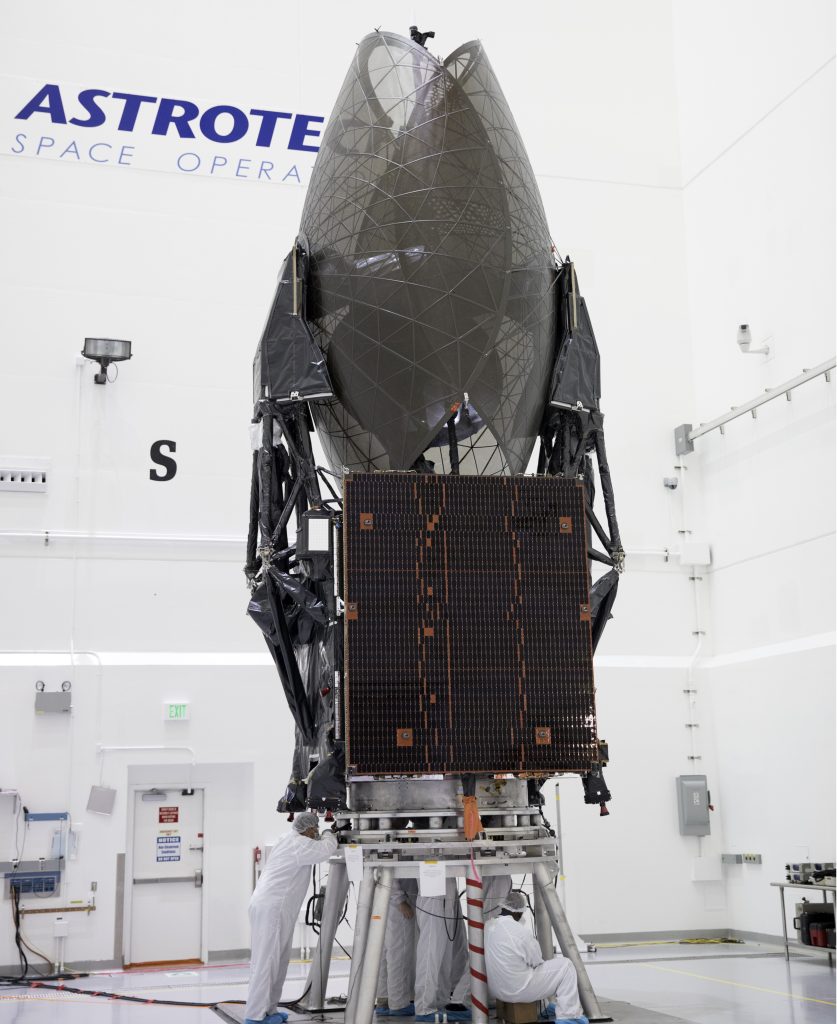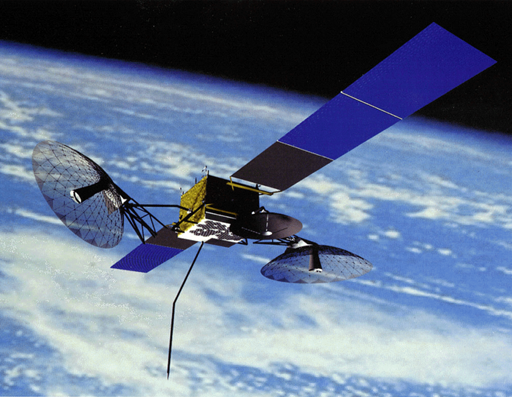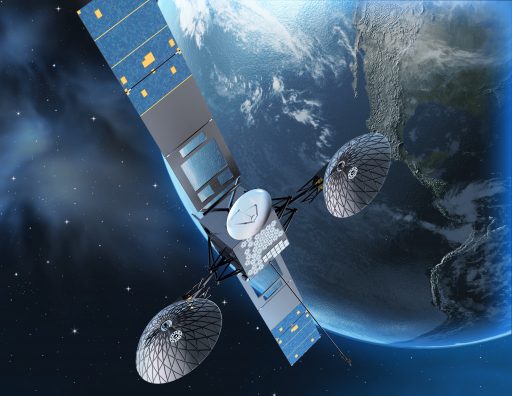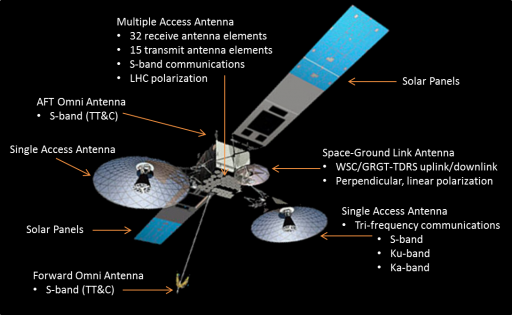TDRS-M Satellite Overview

TDRS-M is a third generation satellite operated by NASA as part of the Tracking and Data Relay Satellite System (TDRSS) that is used to route communications to and from various U.S. Space Assets including the International Space Station, Hubble Space Telescope and various low-orbiting satellites as well as high-altitude balloons, aircraft and the Amundsen-Scott South Pole Station.
TDRSS has been inaugurated in the first half of the 1980s and is currently in its third satellite generation with TDRS-M – to be re-named TDRS-13 – as the third of three planned third generation satellites to be launched, covering services through the end of the 2020s.
.
TDRSS Architecture and History
Before TDRSS, NASA operated a network of ground stations and telephone switching equipment deployed around the world to provide space-to-ground communications for around 15 minutes of every 90-minute orbit – sufficient for uncrewed satellite missions but problematic for human missions.
The Manned Space Flight Network broadened coverage significantly and missions to the Moon were assisted by the Deep Space Network for continuous communications with the Apollo spacecraft.

The operation of ground stations around the globe was also problematic as they were vulnerable to potential political upsets within the host country which at a number of times placed personnel into dangerous situations during the Gemini and Apollo programs. This issue as well as the need for high-data rate communications once the Shuttles began flying prompted NASA to look into establishing a space-based communications infrastructure that would be known as TDRSS.
The TDRS Project was formally initiated in 1973 – initially envisioned to be a two-satellite system with spacecraft in an Eastern and Western slot, though anticipated data needs quickly added a third satellite to the design which also patched up a small Zone Of Exclusion (ZOE) between the two-satellite coverage zones.
The TDRSS system, like any other space-based communications system, comprises the space segment comprising the satellites themselves, a ground support segment and the user terminals aboard spacecraft using TDRSS.

TDRSS operates five ground stations at the White Sands Complex in New Mexico (two stations), the Guam Remote Terminal, Blossom Point in Maryland, and at the Network Control Center at the Goddard Spaceflight Center from where the satellites are monitored and controlled. Each ground station operates 19-meter dishes facilitating the Space-to-Ground Link; Mission Operations are handled at Goddard including satellite maintenance, communication request tasking, data routing and mission planning. Ranging transponder support is provided from White Sands, Guam, Ascension Island and Alice Springs, Australia.
The Space Segment of TDRSS requires three active satellites in Geostationary Orbit for near-100% coverage of the entire Earth, but typically, there are more satellites available that act as spares in a hot-redundancy pattern, ready to be activated should one of the primary satellites fail.

A total of seven first generation TDRSS satellites were launched between April 1983 and July 1995, six of which reached orbit while TDRS-B was lost in the Challenger accident in 1986. All first generation satellites used the Space Shuttle as launch vehicle along with a two-stage Inertial Upper Stage for two boosts from Low Earth Orbit into a near-Geostationary orbit. The first generation satellites, built by TRW, were the first communications satellites with simultaneous three-band frequency service in S-Band, C-Band and high data rate Ku-Band.
Each first generation satellite weighed in at 2,270 Kilograms and featured a pair of S/Ku-Band deployable parabolic antennas that provided the data-intensive single-access service with each steerable antenna capable of supporting two user spacecraft services (one in S- and one in Ku-Band). Multi-access forward and return service was provided by the Earth-facing phased array antenna panel on the satellite’s nadir side with each spacecraft capable of supporting a total of 22 users at any given time. C-Band capability was only available on the first six TDRS satellites before being eliminated from the program.

Built for a ten-year service life, the first generation satellites outlived their planned missions by many years, the first being placed into retirement in mid-2010 followed by TDRS-3 and 4 in 2011 and 2012. As of 2017, three first generation satellites remained in orbital storage locations to be called upon when needed within the active system.
Three second generation TDRSS craft were launched by Atlas IIA rockets in 2000 and 2002. The three satellites were built by Boeing Space Systems based on the Hughes 601 satellite platform for a total contract value of $482 million.
The second generation TDRSS satellites provided continuation and expansion of the existing S- and Ku-Band TDRSS services used by the Space Shuttle, ISS, Hubble, Landsat and dozens of other low-orbiting spacecraft while adding a new Ka-Band capability.
Weighing in at 3,200 Kilograms, the second generation TDRS Satellites (TDRS-8, 9, 10) retained the single-access and multi-access combination realized via a pair of 4.6-meter diameter steerable antenna reflectors for simultaneous two-way S- and Ku or Ka-Band support (single-access) and a phased array antenna panel on the Earth-facing side of the satellite for reception from five spacecraft and transmission to one spacecraft. The second TDRS generation boosts receive data rates to 300 Mbit/s for standard Ku- and Ka-Band and 6 Mbit/s for S-Band with an additional high-data rate Ka-Band mode reaching a receive rate of 800 Mbit/s. Transmit rates are possible up to 25 Mbit/s for Ku/Ka-Band and 300kbit/s for S-Band.

In addition to their service for NASA, the TDRS satellites are extensively used by other U.S. Government Agencies. In fact, the Pentagon covers the majority of TDRSS operational costs and has driven a number of classified requirements for the second and third generations of TDRSS. The National Reconnaissance Office uses TDRSS to augment its own Satellite Data System, operated under the code name Quasar and largely similar to TDRSS in that a series of high-altitude satellites are used to relay data to and from low-orbiting satellites to allow real-time reception of image and radar reconnaissance from around the world.
TDRS Third Generation

NASA selected Boeing in December 2007 to build the third generation of satellites for the Tracking and Data Relay Satellite System, initially ordering two satellites with an option for a third and fourth satellite. The option for the third satellite, TDRS-M, was exercised in November 2011 while an option for a potential fourth satellite was not exercised. TDRS-K, the first third generation satellite was launched in 2013, followed by TDRS-L in 2014 – both using Atlas V 401 launch vehicles.
The three satellites are virtually identical, using Boeing’s BSS-601HP satellite platform – likely representing the last 601 satellites to be ordered as Boeing has moved on to the 702 satellite generation for modern, high-power communications satellites. TDRS-K,LM match the capabilities of their predecessors with added provisions to make services more robust and one major change from the second to the third generation by eliminating onboard beamforming capability for the S-Band multiple access return link, moving back to a ground-based beam-forming and separation as used on the first TDRS generation.

Boeing’s 601 satellite platform was introduced in 1987 to meet the growing demands for high-power, multi-band satellites for TV broadcasting and communication networks in the business and mobile sectors. The initial version of the satellite was baselined for up to 48 transponders and a payload power of 4,800 Watts. BSS-601HP, the high-power version of the satellite platform, debuted in 1995, doubling the capacity of the initial 601 configuration with up to 60 transponders, a payload power of 10,000 Watts and a payload capacity near 700 Kilograms. Another derivative, 601MEO, was developed for application in Medium Earth Orbit, featuring a simplified propulsion system.
All 601 satellites employ a modular design comprising the primary structure that carries all launch loads, facilitates the propulsion system and hosts all bus components such as electrical, command & control, attitude determination and control systems. The payload module represents the second major component of the satellite, using a shelved structure and providing mounting interfaces for antenna feeds and solar arrays with provisions for antennas on three faces of the satellite bus.

The last commercial 601 satellite was ordered in 2001 and launched in 2004, though NASA decided to stick with the platform for its next generation of spacecraft, contracting Boeing for the three TDRS satellites. The TDRS-M satellite is likely the last 601 vehicle to reach orbit.
TDRS-M has a launch mass of 3,454 Kilograms and stands 8.14 meters tall at liftoff, featuring two 7.6-meter long solar arrays that deliver 3,220 Watts during the autumnal equinox and 2,850 Watts during the summer solstice; power is stored in Nickel-Hydrogen batteries for periods of high power demand and solar eclipse season.
The satellite uses stellar navigation, sun and Earth aspect sensors as well as an inertial platform for attitude determination while reaction wheels, magnetic torquers and 10N/22N ACS thrusters provide attitude actuation, designed to keep the satellite’s nadir-facing side pointed to Earth. The thrusters are also used to keep the satellite in its operational slot in Geostationary Orbit, countering orbital perturbations by Earth’s uneven gravitational field and external influences like solar pressure.
The TDRS-K,L,M satellites employ R-4D-11-300 main engines designed back in the days of Apollo by Kaiser Marquardt and now marketed by Aerojet Rocketdyne. R-4D is a regeneratively cooled Liquid Apogee Engine burning a self-igniting mixture of Monomethylhydrazine/Nitrogen Tetroxide. The 490-Newton engine is 0.55 meters long and 0.28 meters in diameter with an unfueled mass of 3.63 kilograms. The engine provides a specific impulse of 312s, has a thrust to weight ratio of 13.7 and operates at a chamber pressure of 6.9 bar. The original RD-4 was developed as an attitude control thruster for the Apollo Service and Lunar Lander modules.

The design of the TDRS payload has not substantially changed from the second to third generation – featuring a pair of 4.6-meter steerable, flexible mesh antenna reflectors that fulfill the single-access function for Ku/Ka- and S-Band, a dedicated, 1.9m diameter Space-to-Ground Link Antenna, and a phased array antenna panel on the Earth-facing side of the satellite for the S-Band multi-access function for up to five receive channels and one transmit channel.
Single-access services are used for data-intensive applications like the International Space Station that typically routes upwards of six video feeds, four voice channels and a large number of telemetry and science channels to the ground at any given time of day.

Each single-access antenna can hold simultaneous two-way communications in S-Band and either Ku/Ka-Band with receive data rates of 800Mbit/s (Ka-Band), 300Mbit/s (Ku-Band) and 6Mbit/s (S-Band) and transmit (ground-TDRSS-ISS) data rates of 25Mbit/s for Ku/Ka (telemetry, TV, Internet, misc. data) and 300kbit/s for S-Band (commanding). Single-access is also employed by the Hubble Space Telescope and short-duration science data dumps from various satellites including the Landsat program.
The Multiple-Access Antenna uses phased array technology with 15 forward antenna elements for the relay of commands to orbiting spacecraft and 32 return elements which accept data from up to five spacecraft simultaneously – both antenna element types operate in Left Hand Circular Polarization. TDRS-K,L,M feature higher-power forward transmitters within the S-Band system for command relay. Another important function provided by TDRS is a ranging service for precise orbit determination for low-orbiting satellites which is crucial for various science missions.
Built for a service life of 15 years, TDRS-M will provide reinforcement of the TDRSS constellation and ensure a continuation of service through the end of the 2020s (ensuring TDRS is able to support the International Space Station through the end of its mission in the second half of the 2020s).

